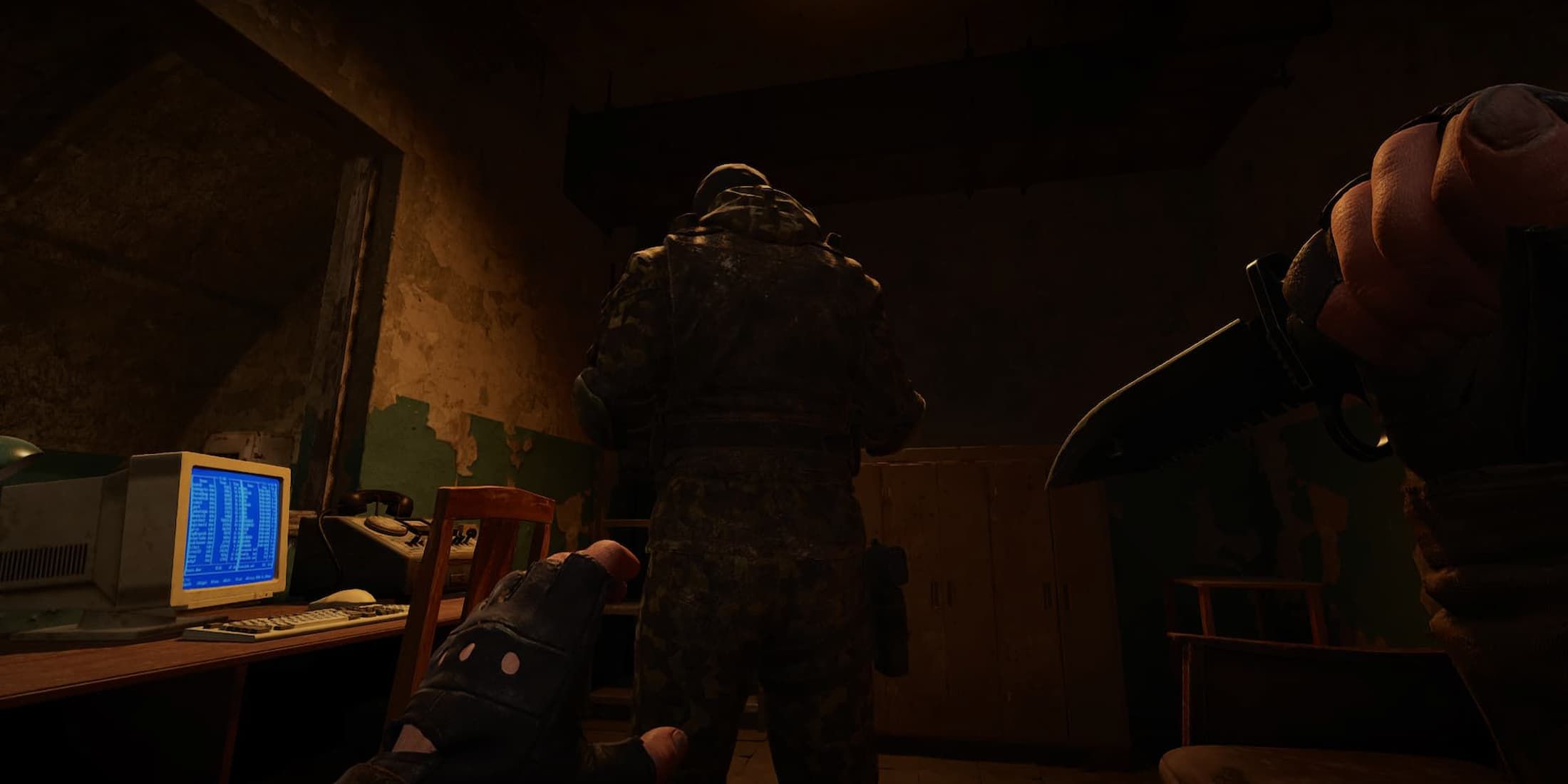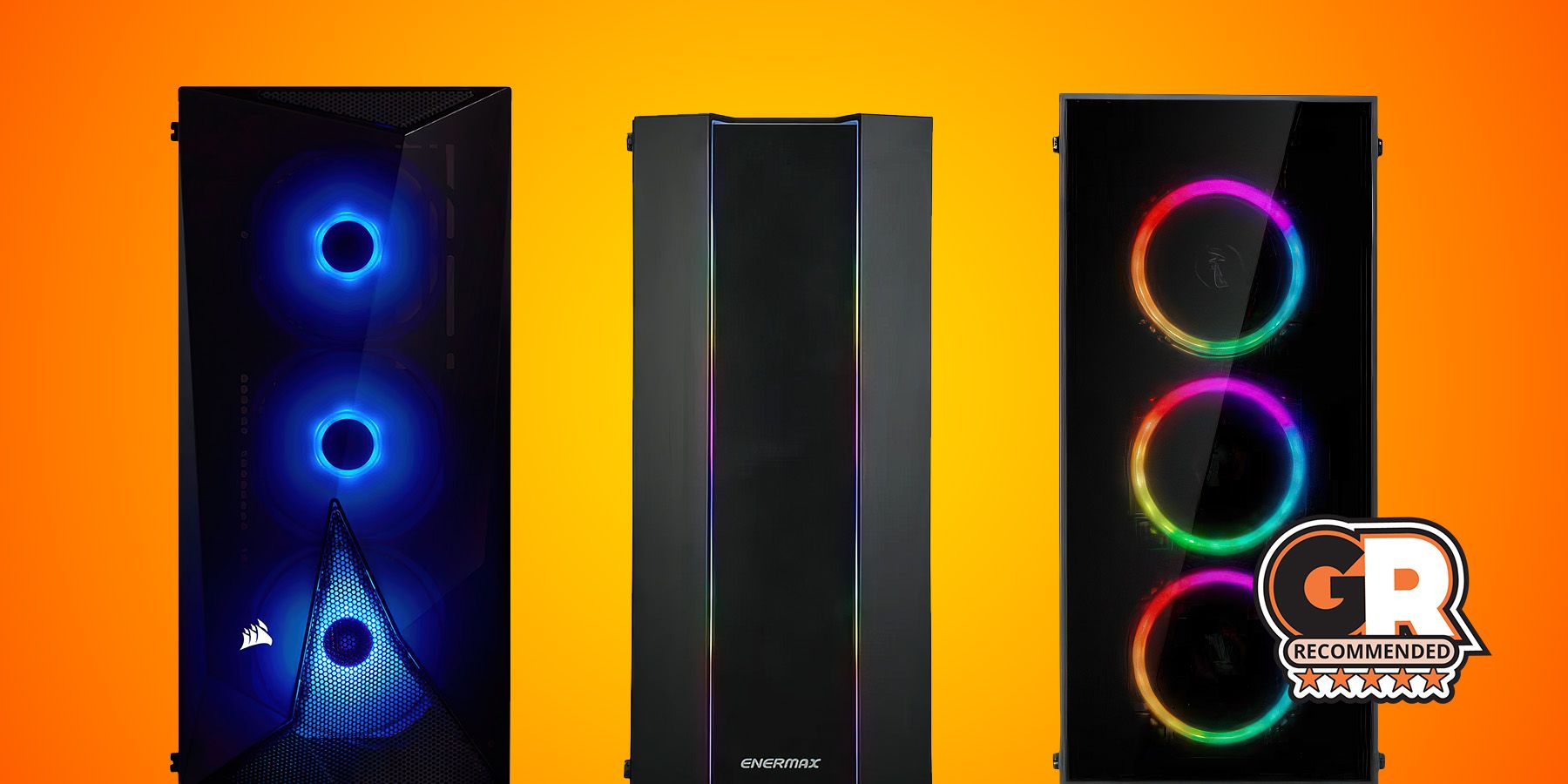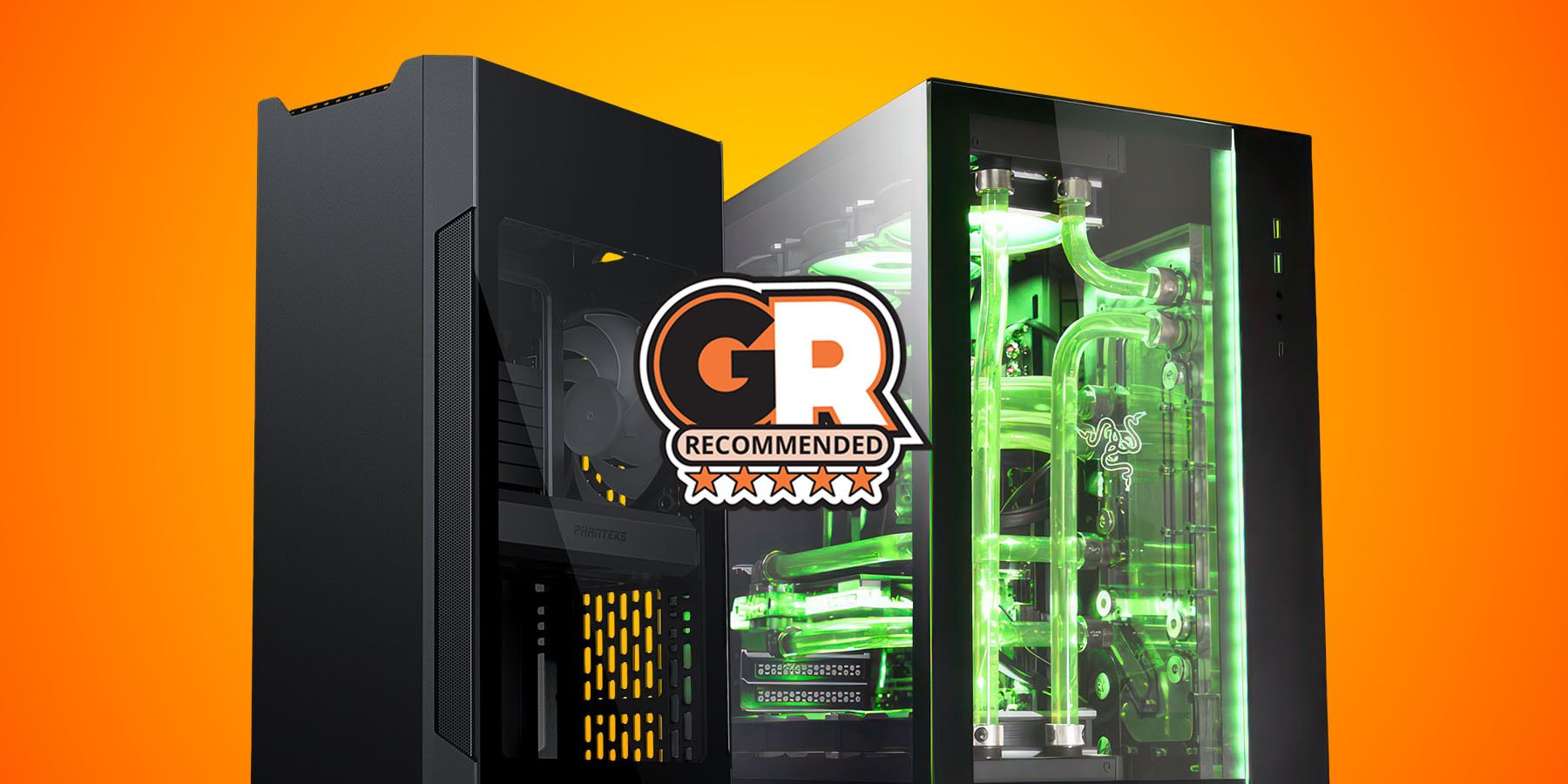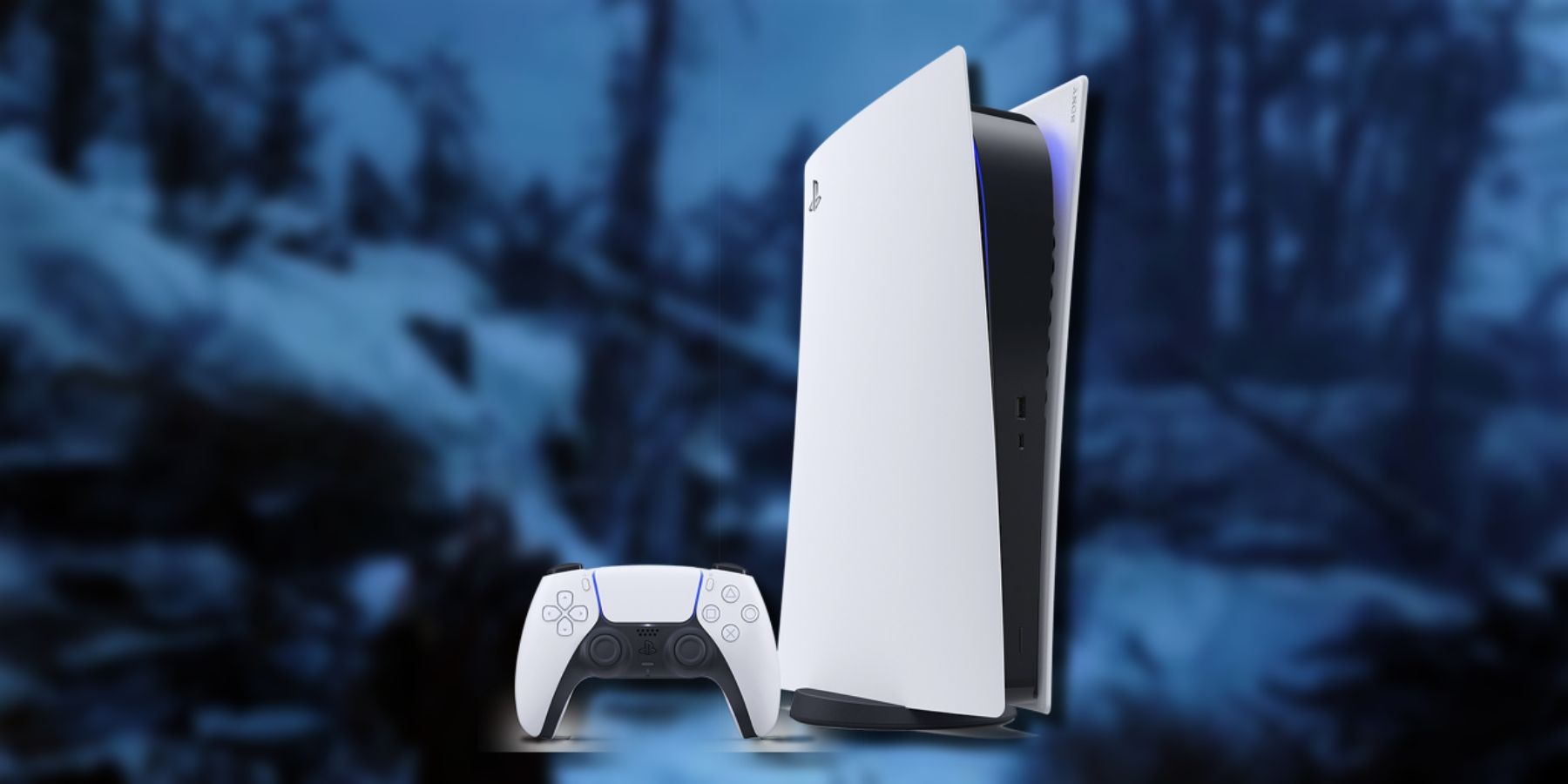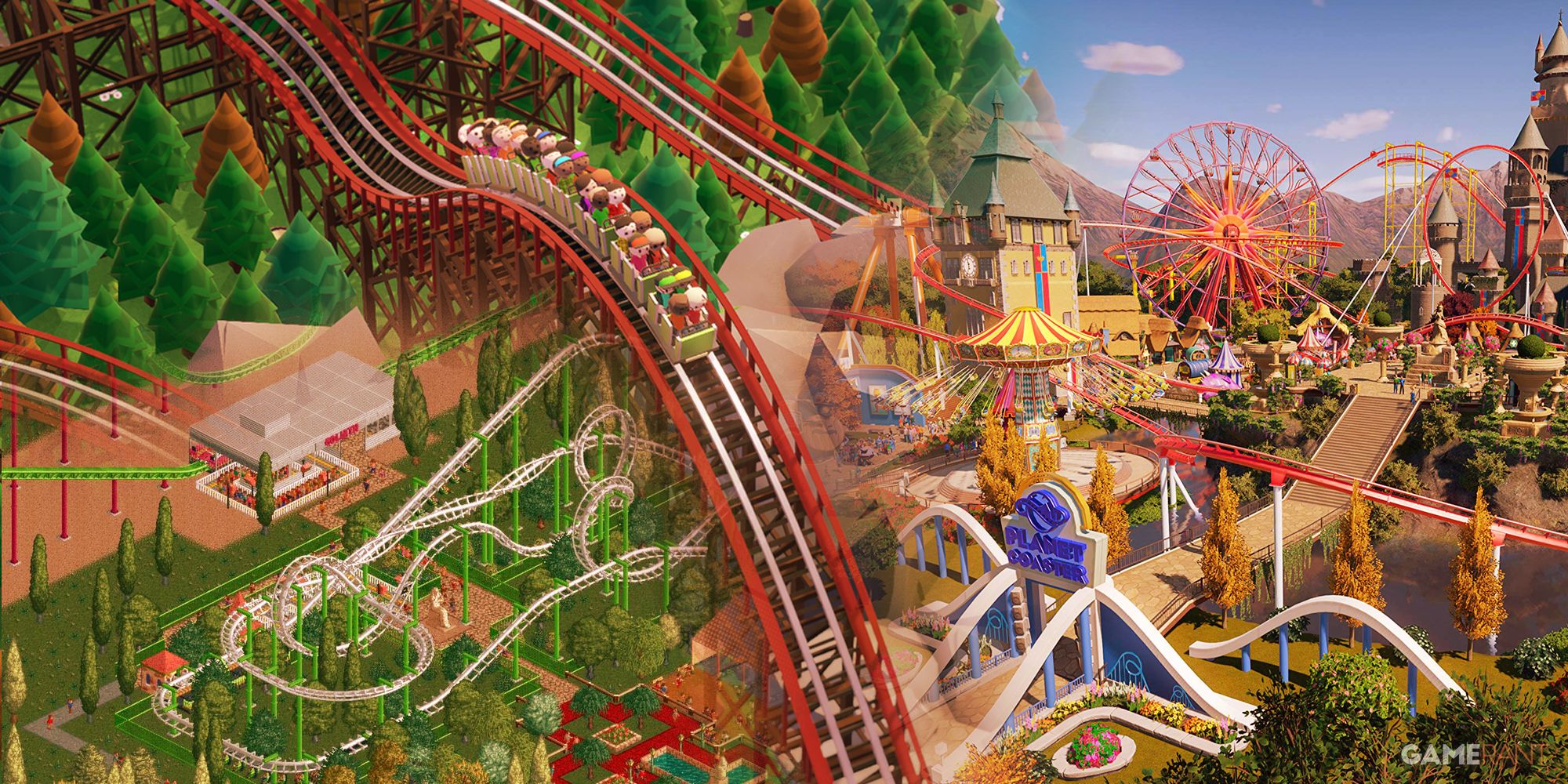The choices for a PC case have never been more diverse than they are today. If gamers decide against a budget prebuilt PC, they can design a rig perfectly suited to their needs. However, a case is the most visible part of a PC and can also dictate what components fit in its chassis. Consequently, system builders must find the correct case that not only meets their requirements now but can also adapt to evolving configurations in the future.
-
LIAN LI LANCOOL 216 PC Case
Best Overall Budget PC Case
-
NZXT H5 Flow
Best Mid-Tower Budget PC Case
-
Phanteks Enthoo Pro 2
Best Full-Tower Budget PC Case
-
Thermaltake Versa H18
Best Compact Budget PC Case
-
Phanteks Evolv Shift 2
Best Budget Mini-ITX Case
How to Find an Affordable PC Case
- Form Factor: A common mistake inexperienced PC builders make is choosing a case that won’t allow them to install larger graphics cards, additional storage, and more cooling as their rigs grow. Larger mid-tower and full-tower cases are more adaptable and can accommodate cooling options for increasingly hot CPUs. Smaller mini-ATX solutions are appropriate for gamers with limited desk space or constructing a power-efficient system.
- Cooling and Airflow: With powerful processors and GPUs generating heat, how much airflow a case promotes is also critical. Some cases ship with a generous amount of preinstalled fans while others allow for additional fans and AIO liquid coolers.
- Build Quality: Cases can vary dramatically with what materials reinforce their chassis and panels. Even among budget cases, buyers will encounter models that use more steel parts than others to survive chaotic gaming desks.
- Aesthetics: The design of a case can completely change the look of a PC and become the focal point of a setup. Beyond a wide variety of color choices, modern cases often include RGB fans and lighting that add some personality to an otherwise ordinary component.
As the following guide demonstrates, a budget does not have to eliminate the best PC cases, regardless of what size or style of enclosure a builder desires.
GameRant’s Picks for the Best Budget PC Cases
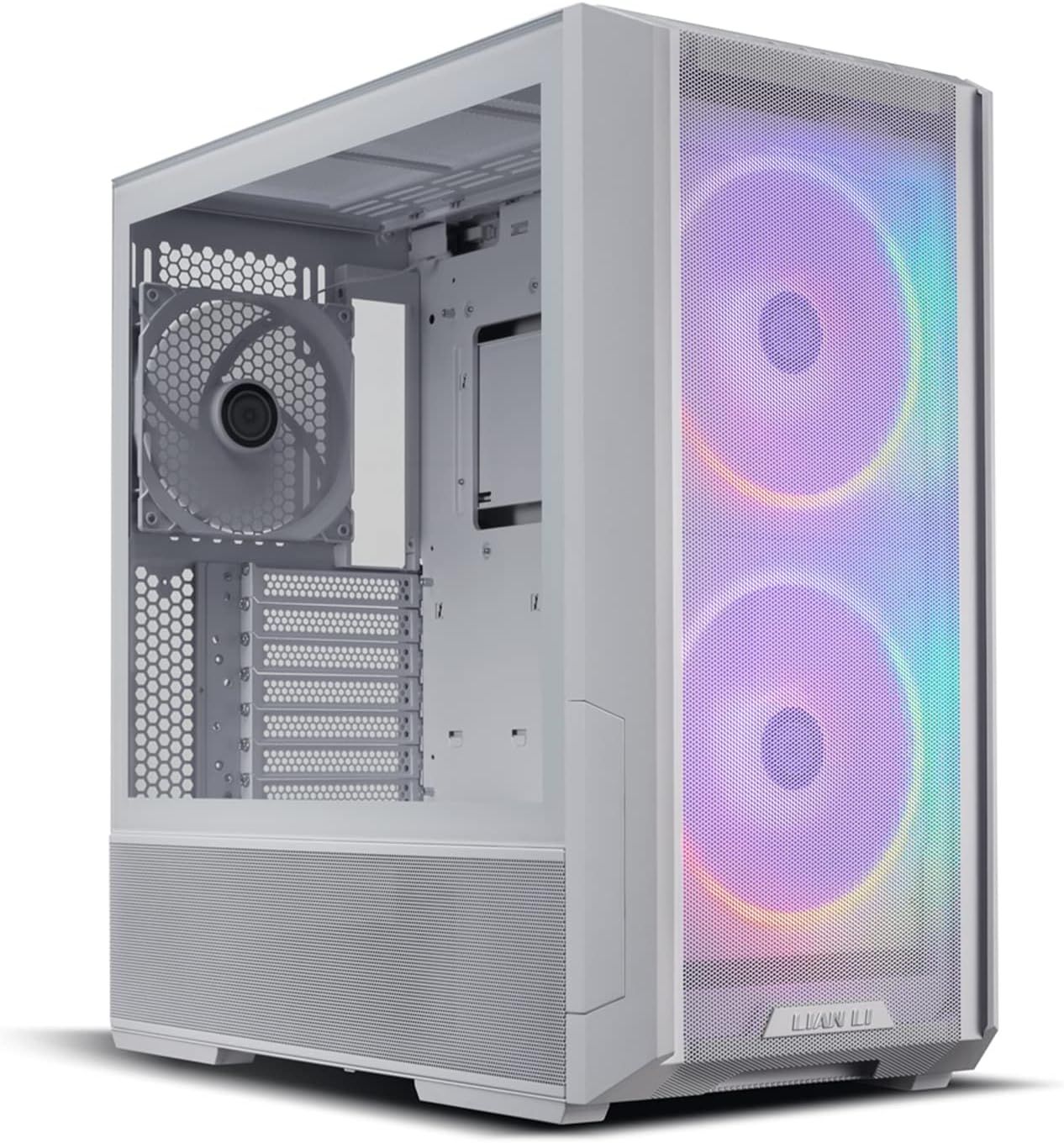
LIAN LI LANCOOL 216 PC Case
Best Overall Budget PC Case
$100 $105 Save $5
The LANCOOL 216 is a mid-tower case with all-around mesh panels for optimal airflow. Thanks to its modular rear panel, it can be optimized for air or water cooling. It includes 2 x 160mm and 1 x 140mm pre-installed PWM fans and an innovative rear PCIe fan bracket to maximize airflow.
- Brand
- LIAN LI
- Material
- Steel / 4.0mm Tempered Glass
- Motherboard Size (Max.)
- E-ATX (Under 280mm)
- Graphics Card Size (Max.)
- 392mm
- 3.5″ Drive Slots
- 2 x 3.5” HDD
- RGB Lighting
- Yes
- Viewing Window
- Yes
- 2.5″ Drive Slots
- 6 x 2.5″ SSD slots
- Power Supply Size (Max.)
- ATX (Under 220mm)
- Exterior Dimensions
- (D) 480.9mm x (W) 235mm x (H) 491.7mm
- Excellent air circulation
- Two 160mm fans included in the case
- Easy to manage cables
- RGB controller and PCIe fan sold separately
To become the best budget PC case, the Lian Li Lancool 216 has to excel with both cooling performance and motherboard compatibility. Mid-tower PC cases are extremely popular because they balance size and their ability to hold both small and large components. The Lian Li Lancool 216 accomplishes that task easily, and its relatively small frame can still support AMD and Intel E-ATX motherboards. Most gamers will probably recognize the name Lian Li for their infamous O11 case, and while that is a great case, the 216 feels like the unsung hero for their lineup, especially for budget-conscious gamers.
The Lancool 216 ships with two front 160 mm RGB fans that cool more efficiently than smaller blowers. Plus, for those gamers running power-hungry GPUs, the rear PCIe 140mm fan, in this case, aims to eliminate thermal throttling problems. Unlike most rear case fans, this fan sits right next to the PCIe slots to ensure that the GPU gets a constant flow of air across it. Front I/O wise, the 216 has an array of connections, including two USB 3.0 ports and a single USB-C port. Like Lian Li’s other cases, the front I/O can be moved to the bottom left corner of the front panel for easier access if the case sits on the desk.
Besides the wealth of features and very reasonable price, the Lancool 216 is an excellent starting case for a new PC builder or a more experienced one who wants to save money. Regardless of the skill level, this case is easy to build in, and its cable management options make it possible to keep the setup looking clean.
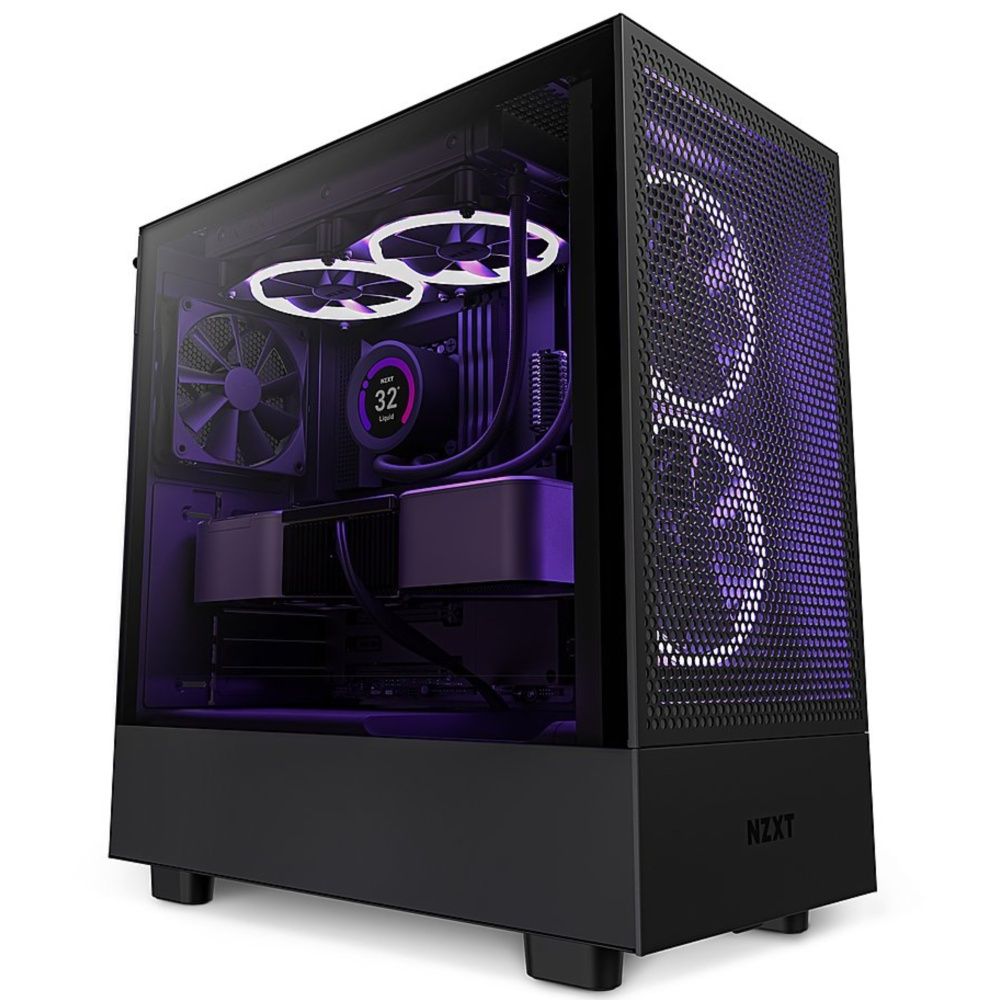
NZXT H5 Flow
Best Mid-Tower Budget PC Case
$85 $95 Save $10
The NZXT H5 Flow is a compact mid-tower ATX PC case ideal for those on a budget. Even though it is a budget-friendly case, it does something that no other case does, which is providing a dedicated fan at the bottom to keep the GPU cool. There is a second fan pre-installed at the rear of the case. The front panel of the H5 Flow is perforated for uninterrupted airflow. There are only one 3.5-inch and two 2.5-inch drive bays inside the H5 Flow.
- Brand
- NZXT
- Material
- SGCC Steel, Ultra-clear Tempered Glass, Dark Tinted Tempered Glass
- Motherboard Size (Max.)
- ATX
- Graphics Card Size (Max.)
- 365mm
- 3.5″ Drive Slots
- 1
- Viewing Window
- Tempered Glass
- 2.5″ Drive Slots
- 2
- Color Options
- Black, White
- Unique angled bottom fan directs air at GPU
- Solid thermal performance
- Many cable management options
- Limited storage options
- Only allows for 280 mm AIO liquid cooler
The compact mid-tower sector has become increasingly competitive, so manufacturers always look to introduce unique features. One issue with smaller cases is that the PSU shroud often occupies most of the bottom panel, preventing cooling upwards toward GPUs. The NZXT H5 Flow solves this issue with a 120 mm fan that sits near the front panel but is angled enough to cool even the most powerful graphics cards. This case is ideal for buyers looking for a space-saving mid-tower option that provides excellent thermal performance and is easy to build in.
Shipping with only the angled GPU fan and an additional rear fan, the H5 Flow surprisingly cools power-hungry CPU and GPUs well. System builders can add two additional fans on the front panel or the top of the chassis, with NZXT also selling an RGB version of the case with a pair of illuminated front fans. However, the smaller chassis of the H5 Flow will prevent buyers from installing 360 mm AIO liquid coolers like the MSI MAG CoreLiquid E360.
Cooling in the NZXT H5 Flow is further enhanced by a large mesh front panel with generously sized perforations. The top of the case is also porous enough to exhaust some of the heat from components that the bottom fan blows upward. Thermal readings for the H5 Flow are outstanding for a compact chassis, even if the intelligent design of the case is responsible for these numbers more than the angled GPU fan.
With numerous cable management options, the NZXT H5 Flow also tries to remove some frustration from working in tight spaces. First-time system builders will appreciate many large pathways for routing cables and the included straps to keep a rig organized. Also, the tempered glass side panel and front panel detach effortlessly without screwdrivers.
Despite some limitations with adding additional radiators and storage, the NZXT H5 Flow is ideal for compact gaming PCs with the largest powerhouse graphics cards.
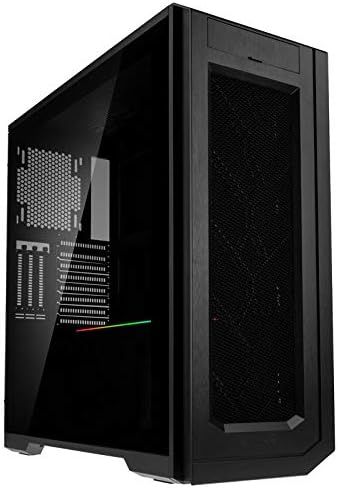
Phanteks Enthoo Pro 2
Best Full-Tower Budget PC Case
$150 $170 Save $20
The Enthoo Pro 2 has been designed with extreme performance in mind, featuring Phanteks’ innovative High-Performance Fabric that sets a new airflow performance standard in the PC enclosure industry. With an incredibly spacious interior, the Enthoo Pro 2 supports up to SSI-EEB motherboard, dual 480 and dual 360 radiator support simultaneously, dual vertical GPU support, and dual system/PSU support.
- Brand
- Phanteks
- Motherboard Size (Max.)
- SSI_EEB
- Graphics Card Size (Max.)
- 503mm
- 3.5″ Drive Slots
- 12
- RGB Lighting
- Optional
- Viewing Window
- Yes
- 2.5″ Drive Slots
- 11
- Exterior Dimensions
- 22.8 x 9.5 x 22.0 inches
- Full-tower case at a budget price
- Can fit two systems inside
- Storage space for 12 hard drives
- No fans included
- Incredibly large footprint
Budget cases have a reputation for being overly compact and unwelcoming to large GPUs and expansion cards. But with the Phanteks Enthoo Pro 2, that’s not a problem. This absolutely massive case is so big that it allows users to assemble two complete Mini ITX systems inside one case. Running out of drive bays should never be a worry with 12 3.5-inch drive trays and 11 2.5-inch SSD trays. And for those gamers who can’t decide between a 360mm or a 480mm radiator, this case can fit both simultaneously. The only drawback is buyers will have to supply their own case fans since none are included.
Of course, most builds will never take up this much space. But for those who want to buy one massive case and never worry about running out of room, at least inside the case, the Enthoo Pro 2 might be the case to go with. And for the monstrous size of this case, the price is actually quite reasonable at around $150.
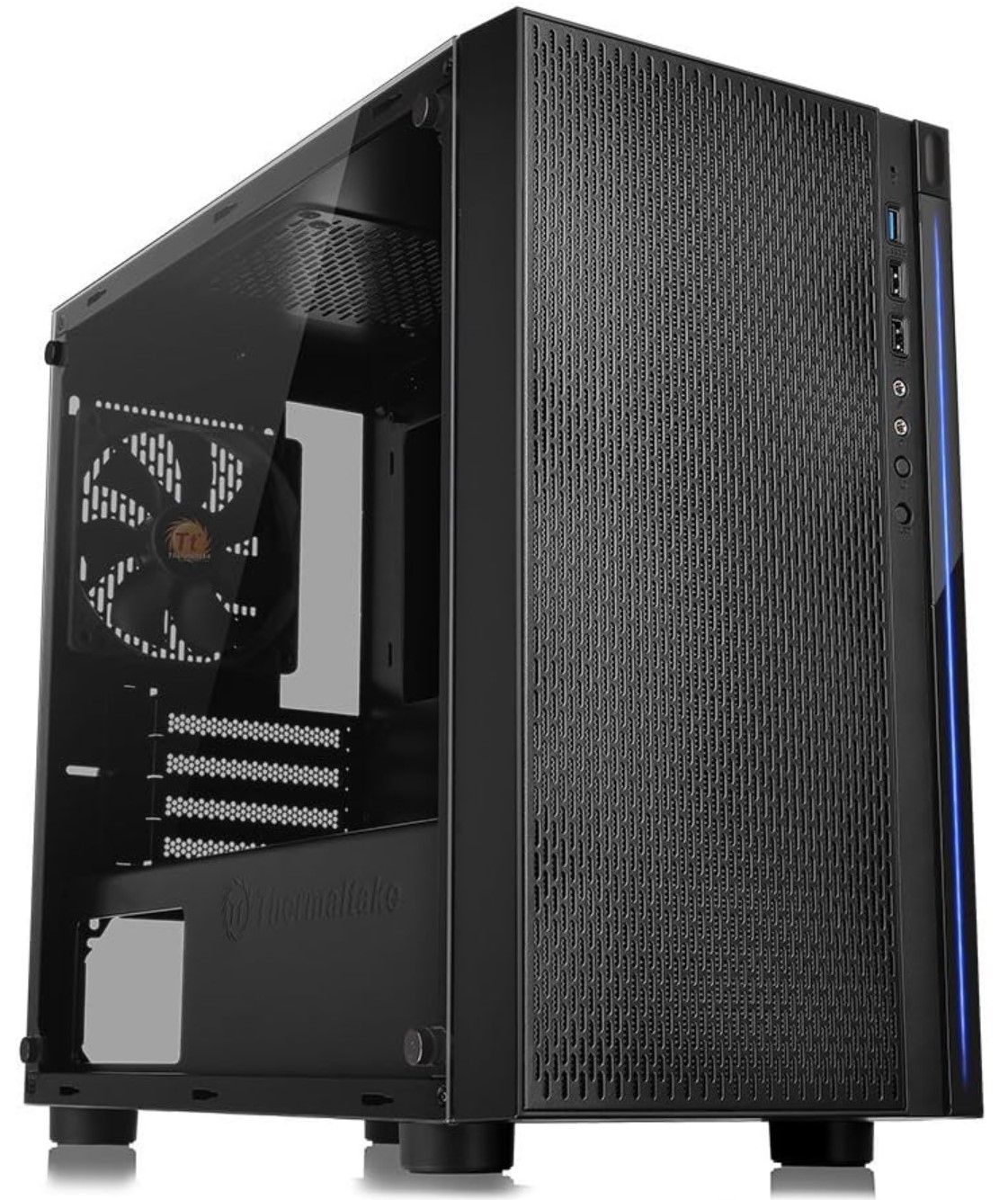
Thermaltake Versa H18
Best Compact Budget PC Case
$44 $55 Save $11
The Thermaltake Versa H18 is an excellent option for new PC builders or gamers assembling a compact, power-efficient rig. The Versa H18 is a Micro-ATX case with an acrylic side window allowing a clear view into the most impressive builds. The mesh front panel maintains an efficient airflow, and the cable routing gap makes hiding unsightly cables behind motherboards simple. Hidden drive bays have room enough for two 2.5-inch and two 3.5-inch storage devices.
- Brand
- Thermaltake
- Material
- SPCC, Tempered glass
- Motherboard Size (Max.)
- 6.7” x 6.7” (Mini ITX), 9.6” x 9.6” (Micro ATX)
- Graphics Card Size (Max.)
- 350 mm
- 3.5″ Drive Slots
- 2
- Viewing Window
- Yes
- 2.5″ Drive Slots
- 2
- Power Supply Size (Max.)
- 220 mm
- Clear side window gives a classy look on a budget
- Simple cable management
- Supports AIO Liquid Cooling
- Lots of plastic parts
- Not the best build quality
The micro-ATX form factor is ideal for gamers who decide against compact prebuilt PCs and decide to put a rig together themselves. Cases like the Thermaltake Versa H18 have just enough space for powerful graphics cards and sufficient cooling while not taking up a massive desk footprint. The tight areas inside small cases can pose a challenge for routing cables, but Thermaltake intelligently encourages hiding wires behind the motherboard tray. With a small micro-ATX chassis, even wires can interfere with airflow, but the cable management here keeps obstacles clear of the included 120 mm rear fan. There are destinations for more fans at the top and rear of the case, and liquid cooling is also possible with places for two radiators.
The Thermaltake Versa H18 isn’t the flashiest-looking case out there, but the blue LED strip gives it enough flair to please many gamers. Also, the transparent side window provides a striking view if builders want to include other RGB-enabled parts in the chassis. The limitations of many micro-ATX cases involve the lack of space for hard drives, but the Thermaltake Versa H18 somehow crams a drive bay large enough for two 3.5-inch hard drives and two SSDs.
The front I/O panel of the Thermaltake Versa H18 provides easy access to one USB 3.0 and two USB 2.0 ports, as well as headset and microphone jacks. As a budget case, the Versa H18 is not the most solid piece of hardware, and there are quite a few plastic parts inside and around the edges of the frame. Still, with a surprising amount of room for graphics cards and ample storage capacity, the Thermaltake Versa H18 ranks among the best budget PC cases to accommodate entry-level CPUs.
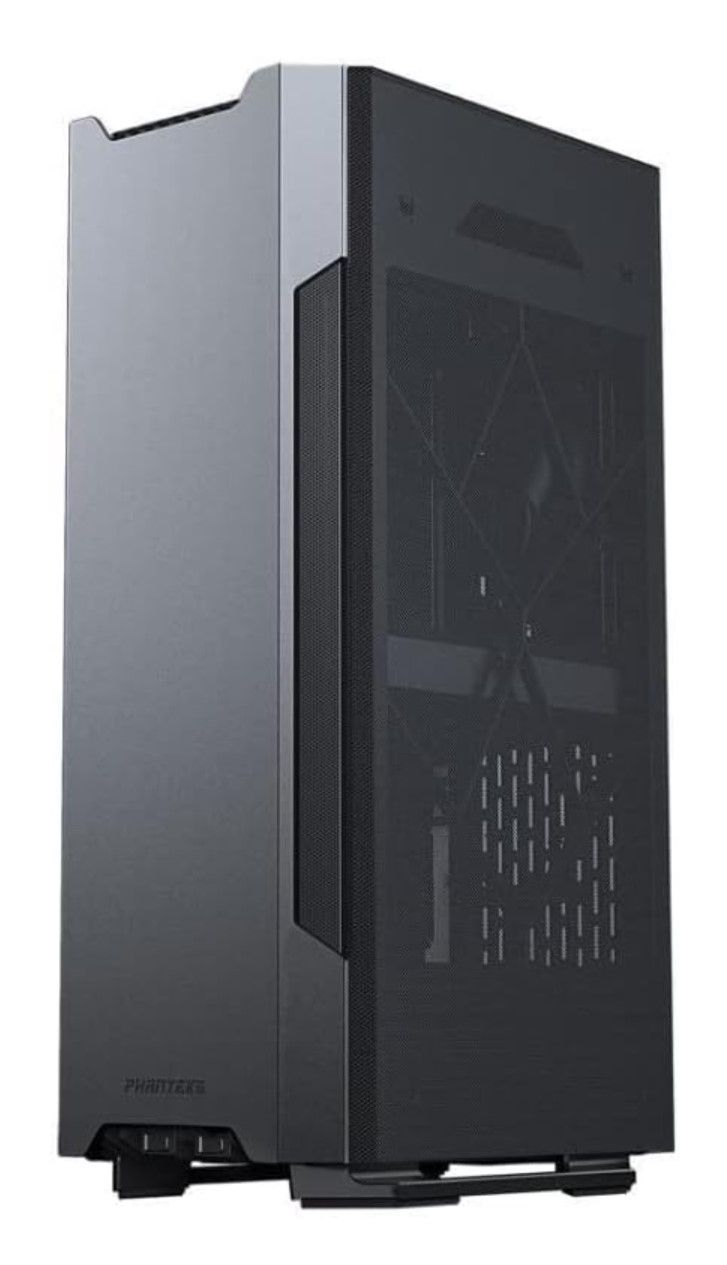
Phanteks Evolv Shift 2
Best Budget Mini-ITX Case
$60 $90 Save $30
For PC gamers who want top-tier performance in an ultra-compact package, the Phanteks Evolv Shift 2 is the case they have been dreaming about. The ingenious vertical design of the Evolv Shift 2 resembles a gaming console, saving valuable desk space. However, it’s far more customizable and accessible than an Xbox or PlayStation, with a pop-up top panel that provides access to the motherboard and rear GPU ports. Despite its Mini-ITX form factor, the Evolv Shift 2 manages to support some of the longest and most powerful graphics cards.
- Brand
- Phanteks
- Material
- Steel/Tempered Glass
- Motherboard Size (Max.)
- Mini-ITX
- Graphics Card Size (Max.)
- 13.2 in length
- 3.5″ Drive Slots
- 1
- RGB Lighting
- Yes
- Viewing Window
- Yes
- 2.5″ Drive Slots
- 4
- Supports large graphics cards
- Affordable for a unique case design
- Saves valuable desk space
- Routing cables is sometimes frustrating
- Temperatures become an issue with tempered glass
The Phanteks Evolv Shift 2 is a mini-ITX case that resembles an Xbox Series X console more than a traditional PC enclosure. Cases designed for the mini-ITX form factor are all compact, but the Evolv Shift 2 takes things to the next level with a slim, vertical profile. Despite its small footprint on a gaming desk, the case accommodates large GPUs, with space for cards over 13 inches in length. The Evolv Shift 2 features a tempered glass window, but there is also the Evolv Shift 2 Air available, which includes a mesh fabric side panel instead.
If a gamer is looking for the best budget PC case that doesn’t look out of place in a living room, the Evolv Shift 2 looks attractive from any side. RGB effects also add to the overall look of the case with an integrated lighting controller. Phanteks only includes one 140mm PWM fan with the Evolv Shift 2, but there are multiple installation points for more RGB fans and LED strips. There is also space for a 120 mm AIO liquid cooler, which comes into play more with the Evolv Shift 2 Air. Sadly, the tempered glass on the Evolv Shift 2 Air simply doesn’t allow air to circulate, as well as the version of the case with a mesh panel.
Once components are installed in the Evolv Shift 2, Phanteks tries to make it as simple as possible to access vital ports while hiding unsightly cables. Instead of having to take off side panels, gamers can access Ethernet, audio connections, and even a graphics card’s video ports by popping up the top cover. It’s a challenge to hide all these cables in such a confined space, but it’s well worth the effort not to have a bunch of wires destroying an otherwise minimalist look.
Storage is often an unfortunate compromise that PC builders must make regarding a mini-ITX case. However, the Evolv Shift 2 saves enough space in its chassis for one 3.5-inch hard drive and up to four 2.5-inch SSDs, depending on whether buyers use the dual SSD bracket.
If a gamer is willing to put a bit more thought into cable management, the Evolv Shift 2 is an opportunity to place a powerful gaming PC anywhere that a tower case is normally an eyesore. The glass panel of the case gives a modern and sleek aesthetic, but builders using top-tier or overclocked CPUs and GPUS will want to consider the Evolv Shift 2 Air for more efficient cooling.
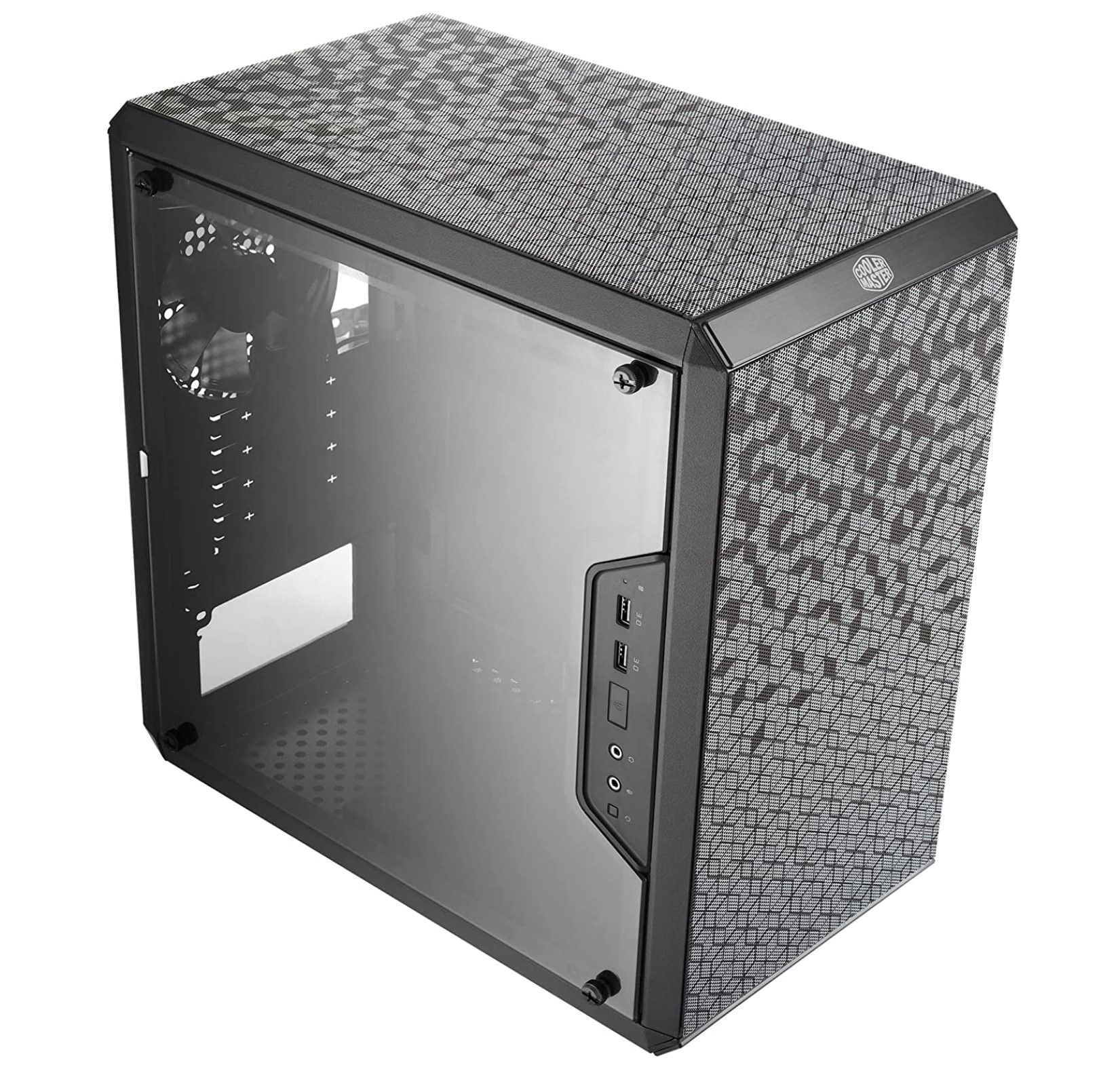
Cooler Master MasterBox Q300L
Best Budget Micro-ATX PC Case
The Cooler Master MasterBox Q300L is a Micro ATX tower case that’s all about flexibility. The case’s I/O panel can be installed in six different positions and the case is suited for vertical or horizontal positioning. A clear side window gives a view into a modern gaming rig. A front magnetic dust filter with a perforated front allows for constant airflow in and out of the case.
- Brand
- Cooler Master
- Material
- Steel, Plastic
- Motherboard Size (Max.)
- Micro ATX, Mini ITX
- Graphics Card Size (Max.)
- 360 mm
- 3.5″ Drive Slots
- 1
- RGB Lighting
- No
- Viewing Window
- Left acrylic
- 2.5″ Drive Slots
- 2
- Power Supply Size (Max.)
- 160 mm
- Exterior Dimensions
- 387 x 230 x 381mm
- Unique-looking dust panels
- Case can be positioned vertically or horizontally
- Multiple placement options for I/O panel
- Large window shows off builds
- Window is not tempered glass
- PSU shroud difficult to work with
The Cooler Master Masterbox Q300L is another excellent case for compact builds or home theater PCs. Although it supports the micro ITX standard, the dimensions of the case also make it excel among mini ATX contenders. What stands out the most about the Masterbox Q300L is its versatility and modular characteristics. With a feature not often seen even in the most expensive cases, installers can place the I/O panel on both sides of the chassis or the top of the Q300L. The ports buyers will have at their disposal include two USB 3.0 connections and standard audio and microphone jacks.
Cooler Master’s Masterbox Q300L is designed for horizontal or vertical placement, and the modular front I/O panel allows builders access to ports with either option. This flexibility enables gamers to find a home for the case on any cramped gaming desk or next to other components on a TV stand. Visitors might still notice the compact Q300L regardless because of its front and top dust filters, which have a unique geometric pattern featuring light and dark-colored cubes. Also, even though its left panel is acrylic rather than tempered glass, it shows off most of the inside of the chassis, including the power supply, which is mostly exposed at the bottom of the case.
Buyers must consider cooling since the Masterbox Q300L only ships with only one pre-installed rear fan. Still, the front of the case can house another 120 or 140 mm fan, while the top of the Masterbox Q300L holds up to two 120 mm fans. Surprisingly, there is just enough room in the case for a 120 mm or 240 mm liquid cooling radiator on its front side or a single 120 mm radiator toward its rear panel. Clearance for vital components like the GPU and CPU coolers is also generous enough to accommodate most small form factor builds. However, the distance between the top of the PSU and the bottom of motherboards is so minimal that connecting cables can become an issue.
If builders install enough fans or a compact AIO liquid cooler, airflow is excellent in the Masterbox Q300L. The mesh filters or cutouts on every side of the case ensure that CPUs and GPUs have adequate space to dissipate their heat despite tight quarters.
The Cooler Master Masterbox Q300L is one of the most inexpensive entries in this guide. While a healthy amount of plastic is used in its construction, its flexible design makes it one of the best budget PC cases for newer installers to customize a build.
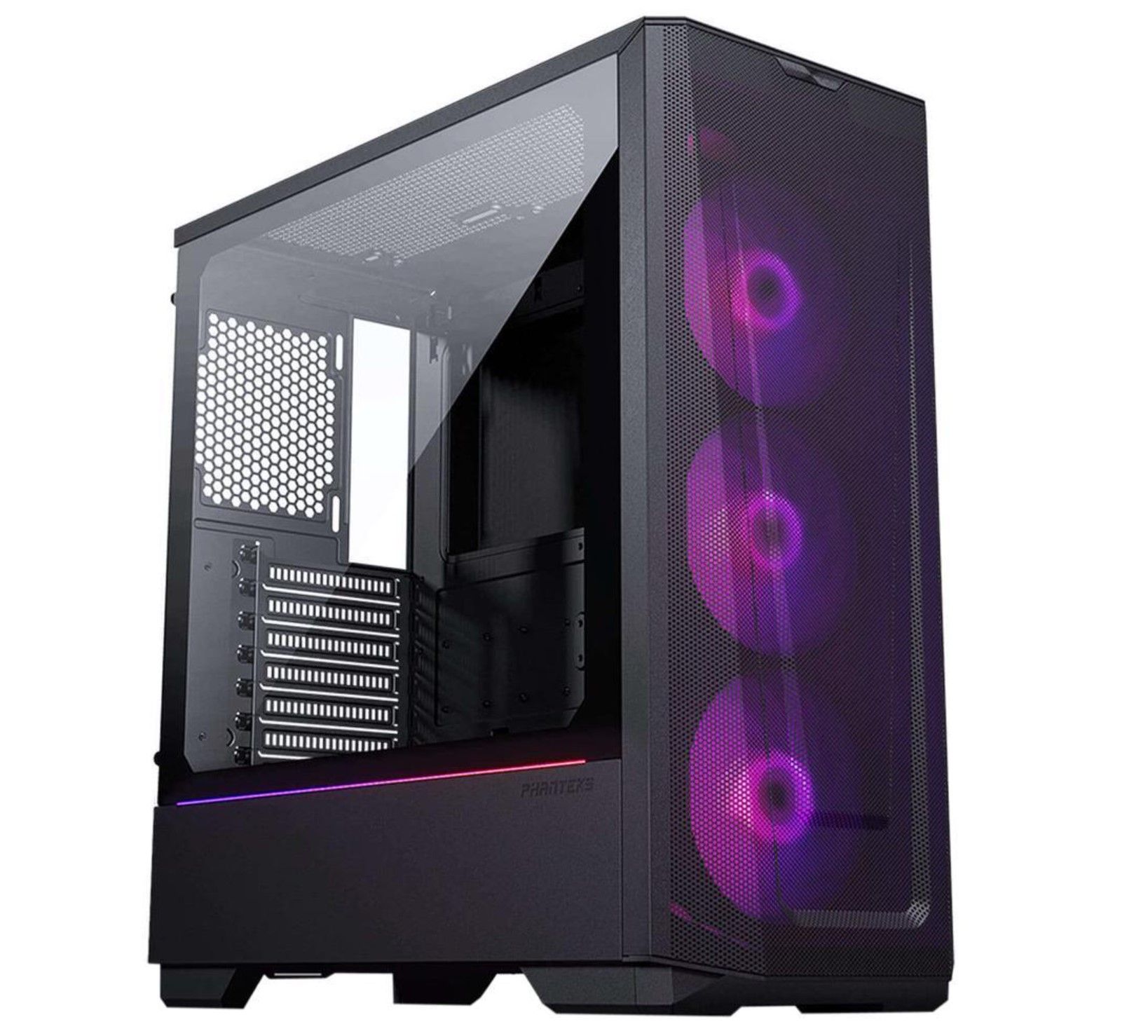
Phanteks Eclipse G360A
Best Mesh Budget PC Case
$70 $80 Save $10
The Phanteks Eclipse G360A is a mid-tower ATX case that benefits from an enlarged ultra-fine mesh front panel for maximum air circulation. This case is also a tremendous value considering it includes 3 A-RGB PWM fans, an LED light strip above the PSU shroud, and a controller box. Although its chassis is fairly compact, system builders can add three 120 mm fans or a 360 mm AIO liquid cooling radiator on the front or top panels. The Phanteks Eclipse G360A is also spacious enough to accommodate the largest graphics cards and even some E-ATX motherboards.
- Brand
- Phanteks
- Material
- Steel, Tempered Glass
- Motherboard Size (Max.)
- Micro ATX / ATX / Mini ITX / E-ATX (up to 280mm wide)
- Graphics Card Size (Max.)
- 400 mm
- 3.5″ Drive Slots
- 2
- Viewing Window
- Yes
- 2.5″ Drive Slots
- 3
- Color Options
- Black, White
- RGB Lighting
- Yes
- Power Supply Size (Max.)
- 220 mm
- Massive mesh front panel for maximum air intake
- Includes three ARGB fans and controller
- Room for the largest graphics cards and AIO liquid coolers
- Thin chassis limits CPU cooler options
- Cable routing can be challenging
Mesh panels are the most common way to promote airflow into and out of a case. The Phanteks Eclipse G360A has neverending competition among mid-tower ATX cases employing mesh materials but nonetheless stands out from the crowd. With an expansive perforated front panel and a trio of included ARGB fans, the Eclipse G360A is a stylish gaming case with tremendous cooling potential.
The mesh panel that covers the front of the case from the top to the bottom is the defining feature of the Eclipse G360A. Manufacturers take many approaches with mesh, but Phanteks opts to minimize the size of the openings and stretch the metal panel around the front of the chassis. This results in maximum airflow without reducing the impact of the three ARGB fans. The fact that the Eclipse G360A ships with this many PWM fans, a controller box, and an LED strip running along the side of its PSU shroud makes it an attractive value in budget cases.
While the Eclipse G360A is still reasonably compact, it offers more flexibility than a smaller mid-tower case like the NZXT H5 Flow. System builders can install three additional 120 mm fans on the top of the case or add a 360 mm AIO liquid cooling radiator. However, while the chassis is wide and tall enough even for some E-ATX motherboards, the case is too thin to house the tallest CPU coolers. The Eclipse G360A could also benefit from additional cable routing pathways since the hard drive cage is not easily removable, and space is at a premium near the PSU shroud.
A few minor annoyances aren’t enough to make the Phanteks Eclipse G360A any less tempting at its low price point. The front mesh panel promotes stellar thermal performance, while gamers will receive more included ARGB lighting than any other similarly priced mid-tower case.
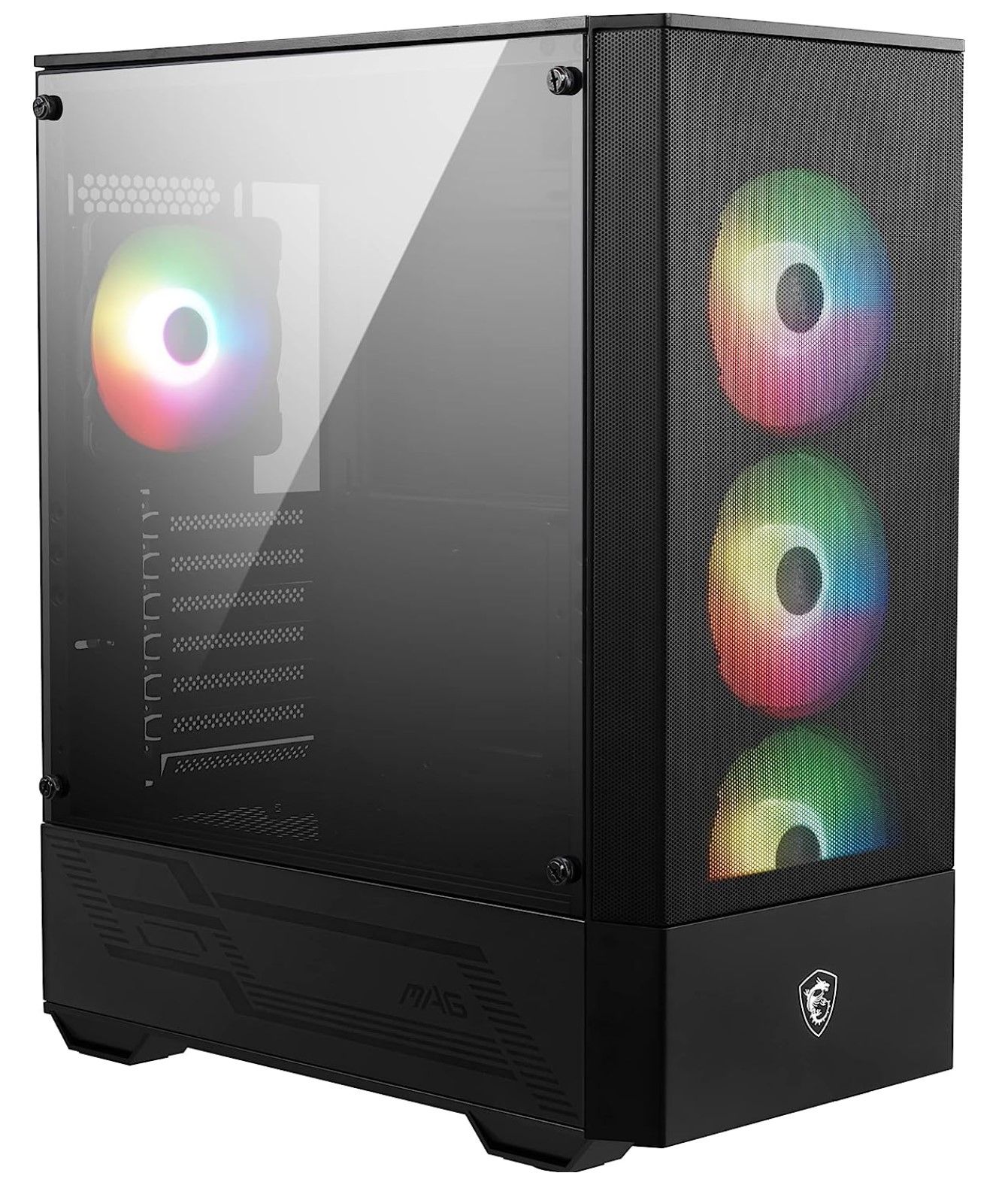
MSI MAG Forge 112R Case
Best RGB Budget PC Case
The MSI MAG Forge 112R is an excellent affordable case for both gamers and content creators. Featuring 4 ARGB fans and an included controller box, the case lights up with some spectacular preset effects. A 4 mm tempered glass panel showcases the best components and is easily removed without tools. The case accommodates liquid cooling radiators and promotes efficient cooling through its mesh front panel.
- Brand
- MSI
- Material
- Steel, Tempered Glass
- Motherboard Size (Max.)
- ATX / M ATX / ITX
- Graphics Card Size (Max.)
- 330 mm/ 13 inches
- 3.5″ Drive Slots
- 2
- RGB Lighting
- Yes
- Viewing Window
- Yes
- 2.5″ Drive Slots
- 3
- Power Supply Size (Max.)
- Standard ATX, max up to 200mm
- Exterior Dimensions
- 16.1 x 8.43 x 19.9 inches
- Four ARGB fans with controller included
- Mesh front showcases lighting while promoting airflow
- Versatile cooling options
- No USB-C port on I/O panel
- Front panel blocks bottom fan
With so many PC cases that look relatively alike, the MSI MAG Forge 112R is a mid-tower case that refuses to blend in with the crowd. A heavy dose of lighting effects and an included controller separate this case from other budget RGB alternatives. Buyers will also have a head start on effectively cooling components in its chassis since it ships with three ARGB fans near its front panel and one rear illuminated fan. Gamers can add up to three additional fans, and the lighting controller affixed inside the MAG Forge 112R’s right panel accommodates additional ARGB components. Although it doesn’t control fan speed, builders can allow a button on the I/O panel to toggle through lighting patterns or connect the controller to a motherboard header.
The MAG Forge 112R is in the more compact category of mid-tower cases, making its cooling capabilities more impressive. Buyers can place a 240 mm AIO liquid cooler on the front or top of the chassis, and a mesh front panel promotes airflow into or out of a case, depending on fan configuration. Unfortunately, due to its relative compactness, the third preinstalled fan on the front panel is partially obscured by the solid black bottom edge. Even so, most gamers will find that the MAG Forge 112R is an attractive addition to a stylish gaming rig, especially with its tempered glass left panel.
Builders should discover that the MAG Forge 112R is refreshingly simple to work with thanks to a tool-less left panel. There is also ample breathing room for graphics cards and CPUs since the case can fit a GPU of up to 330 mm in length and an air cooler that’s 160 mm high. The MAG Forge 112R is not the best choice for a file server, but it can house three 2.5-inch SSDs or two 3.5-inch hard drives. The front I/O panel is a minor disappointment since there are only two USB 3.0 ports, and it comes without a USB-C port, which is becoming commonplace in newer cases.
GameRant found in its review of the MAG Forge 112R that this case leads the pack of smaller mid-range contenders because of its four controllable illuminated fans and ease of use.
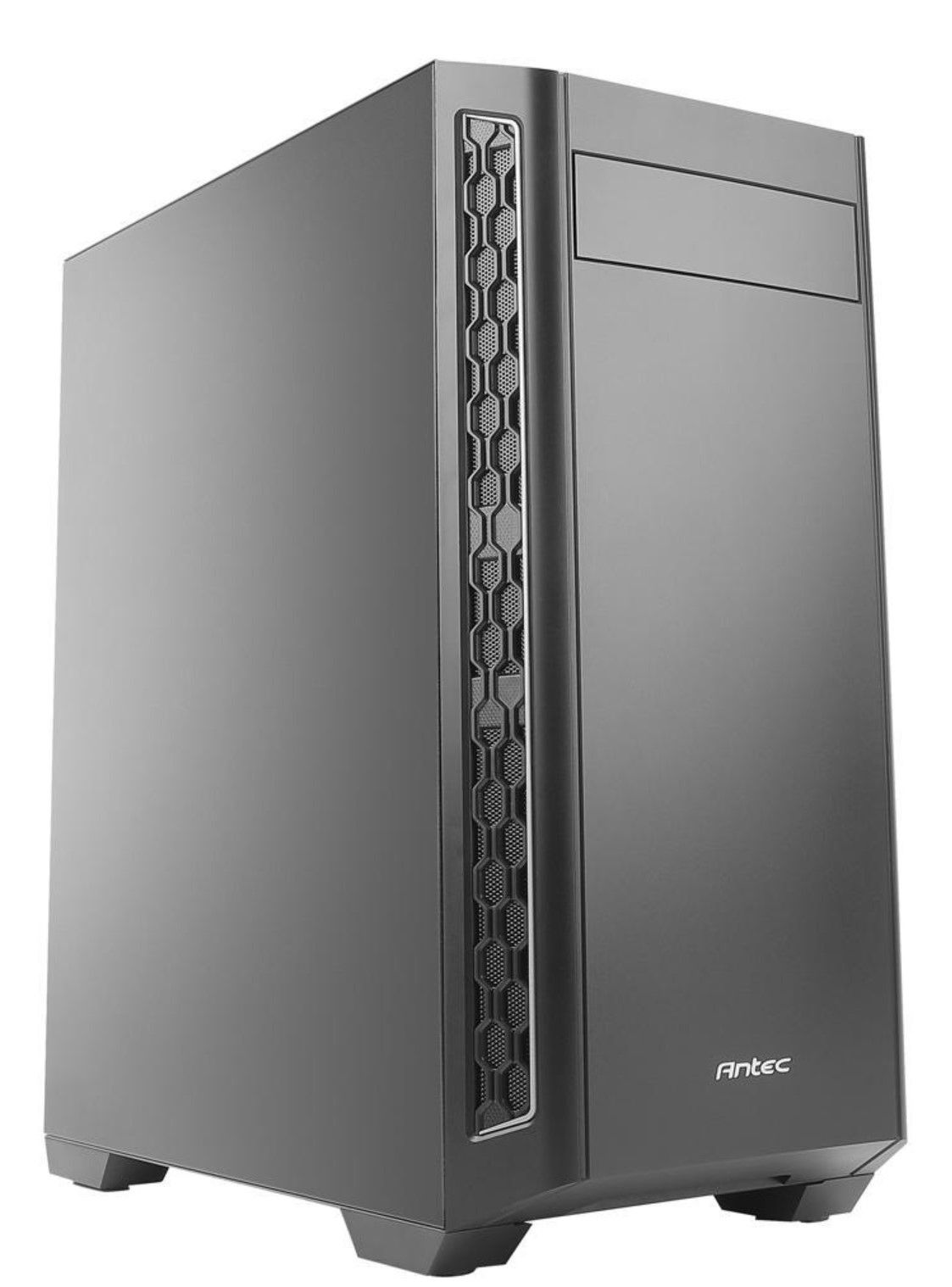
Antec Performance Series P7 Neo Case
Best Silent Budget PC Case
$75 $90 Save $15
The Antec Performance Series P7 Neo Case is a mid-tower case for gamers who value the efficient and silent performance of their components. The P7 Neo employs sound-dampening side panels to drown out loud fans from CPU coolers and graphics cards. To maintain its clean classic look, the P7 Neo places front air intake vents on the sides of the front panel. The rock-solid case proudly maintains the Antec tradition of superior build quality and offers ample space in its chassis for motherboards up to E-ATX size.
- Brand
- Antec
- Material
- Steel, Plastic
- Motherboard Size (Max.)
- Micro ATX / ATX / Mini ITX / E-ATX
- Graphics Card Size (Max.)
- 13.8 inches
- 3.5″ Drive Slots
- 2
- RGB Lighting
- No
- Viewing Window
- No
- 2.5″ Drive Slots
- 2
- Room for 5.25-inch drive
- Sound-dampening side panels
- Excellent build quality
- No RGB or tempered glass
- Design looks dated to some
In a sea of tempered glass and RGB fans, the Antec Performance Series P7 Neo is a mid-tower case that offers an alternative with a classic design. The focus of the P7 Neo is on Antec’s usual top-flight build quality and on silencing noisy components like CPU, GPU, and case fans. While there is no tempered glass, Antec takes advantage of the lack of a window with sound-dampening foam on the side panels. The P7 Neo is not completely devoid of exterior styling, using air vents placed just to the sides of the front panel.
Faithful to the throwback approach of the Antec Performance Series P7 Neo, the case has some features lacking in most contemporary competitors. In addition to the four drive slots for hard drives and SSDs, the P7 Neo also provides a rarer 5.25-inch slot for nearly forgotten optical drives. The case can hold larger E-ATX motherboards only after sacrificing the 5.25-inch bay. The fact is that many gamers add RGB fans for the sake of looks, and the fans shipped with the P7 Neo (two front and one rear) provide adequate airflow for most builds. Even with a somewhat dated design, the case accommodates liquid cooling systems with installation points for multiple radiators on the front and rear.
The Antec Performance Series P7 Neo Case stands out among other cheap PC cases with a profile that blends in perfectly in office and gaming environments. Also, the sound-dampening features of the P7 Neo simplify an often perilous quest to create a silent PC build. For any gamer who isn’t obsessed with rigs that look like neon billboards, the Antec Performance Series P7 Neo Case is a tempting purchase.

Corsair 4000D Airflow
Best Cooling Budget PC Case
The CORSAIR 4000D AIRFLOW is a mid-tower ATX case with easy cable management and exceptional cooling. A steel front panel with triangular cutouts offers optimal airflow to components, accompanied by two included 120 mm AirGuide fans designed with anti-vortex vanes that enhance cooling. The CORSAIR RapidRoute cable management system makes it effortless to route major cables through a single channel, with 25mm of routing depth.
- Brand
- Corsair
- Motherboard Size (Max.)
- ATX
- Graphics Card Size (Max.)
- 360 mm / 14.173″
- 3.5″ Drive Slots
- 2 x Internal 3.5″
- Viewing Window
- Yes
- 2.5″ Drive Slots
- 2 x Internal 2.5″
- Triangular cutouts promote airflow
- Fairly compact but accommodates many cooling options
- Good build quality
- Only two fans included
- Limited number of ports on top of case
Gamers who build PCs with high-end components like the Intel 13700K go to great lengths to keep their investments from overheating. Even with the rising popularity of liquid cooling systems, there remains no substitute for a PC case that facilitates airflow in and out of its chassis. The Corsair 4000D Airflow has unique design elements that complement AIO water coolers and traditional fans.
The most obvious physical feature of the Corsair 4000D Airflow that repeats itself throughout the case is the steel triangular grate on its front. While some gamers may prefer a solid piece of tempered glass, Corsair is betting that this unique pattern is stylish enough to appeal to most buyers. However, Corsair balances function and modern styling by including a glass side panel. The triangular cutouts are also found on the case’s interior, including above the power supply and with the slot covers on the rear.
It’s somewhat surprising that in a case that’s all about maximum cooling, Corsair only ships two 120mm AirGuide fans with the 4000D Airflow. However, these aren’t run-of-the-mill cooling fans, as they rely on anti-vortex vanes to push a more concentrated airflow deeper into a chassis. There is also room for six 120 mm or four 140 mm fans on the front top or back of the case. The triangle-heavy front of the 4000D Airflow really comes alive with the addition of some RGB fans. Liquid cooling is another perfectly viable solution to keep temperatures in check, with several areas ideal for radiators.
Even as a mid-tower case, the Corsair 4000D Airflow is a fairly compact and minimalist enclosure. Unfortunately, this simplicity also affects its front I/O ports, with only two USB 3.0 and 3.1 ports available. Regardless, the 4000D Airflow’s ability to become a rectangular slice of Antarctica makes it a seriously tempting choice. The Corsair 4000D Airflow is the best budget PC case for any gamer who wants to overclock CPUs and GPUs without taking unnecessary risks.
For a prebuilt PC that takes advantage of this case’s extensive cooling potential, check out GameRant’s review of the Origin PC Neuron Corsair 4000D Airflow.
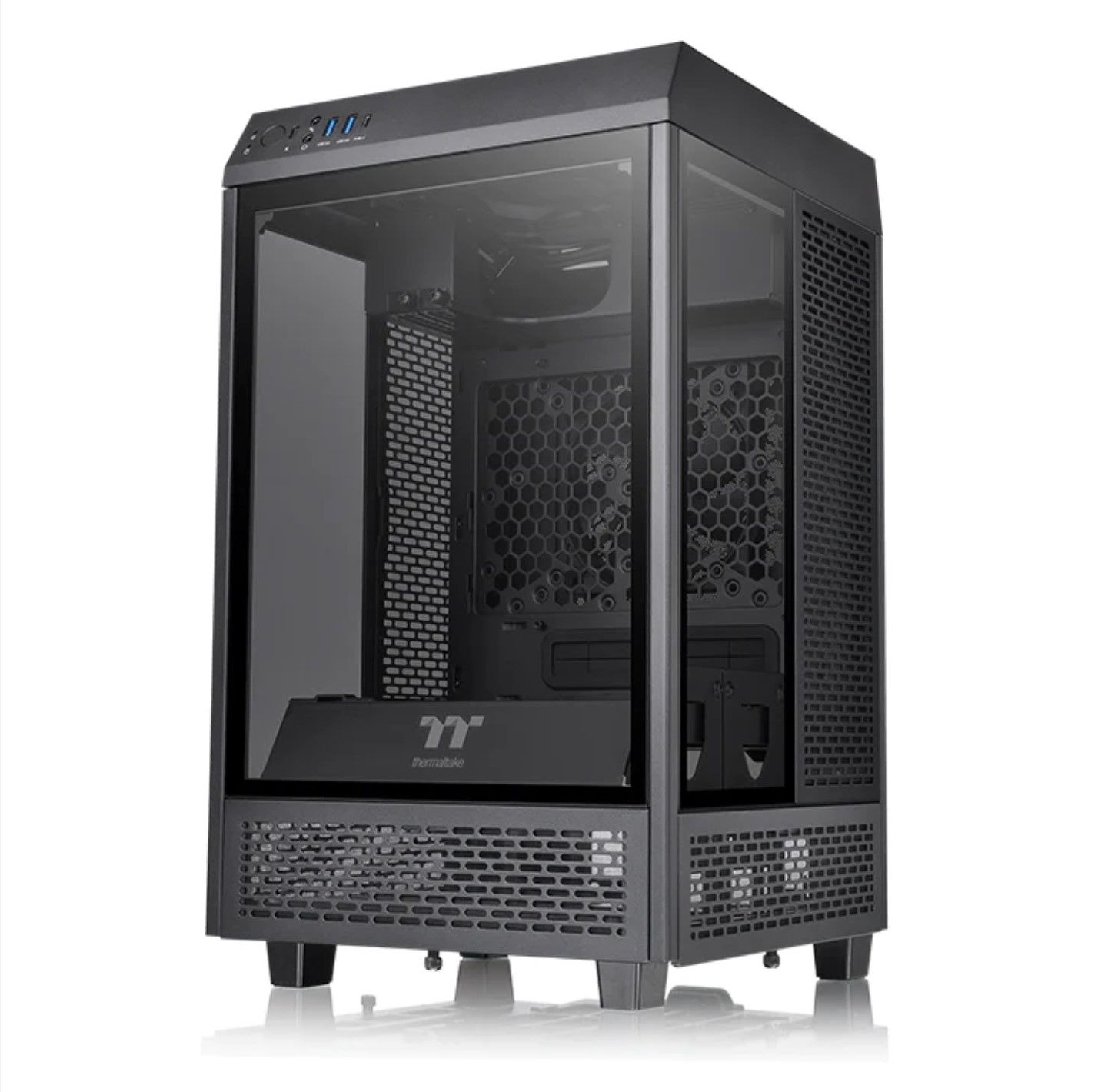
Thermaltake The Tower 100
Best Vertical Tower Budget PC Case
$90 $100 Save $10
With a unique vertical orientation, the Thermaltake The Tower 100 showcases builds with a trio of tempered glass panels on its front and sides. This case is designed to take up as little space as possible on a desktop while not limiting options for system builders. Even in its compact mini ITX form factor, The Tower 100 can accommodate long RTX 30 series graphics cards. With large vents around the case and eight dust filters, The Tower 100’s thermal performance is as impressive as its appearance.
- Brand
- Thermaltake
- Material
- Steel, Tempered Glass
- Motherboard Size (Max.)
- 6.7″ x 6.7″ (Mini ITX)
- Graphics Card Size (Max.)
- 330 mm
- 3.5″ Drive Slots
- 2
- Viewing Window
- Yes
- 2.5″ Drive Slots
- 2
- Color Options
- Black, Snow
- RGB Lighting
- No
- Power Supply Size (Max.)
- 180 mm
- Exterior Dimensions
- 18.2″ x 10.5″ x 10.5″
- Showcases gaming rigs with three tempered glass panels
- Accessible IO panel with USB-C port
- Large vents and eight dust filters
- Difficult to access inside of chassis
- No RGB fans included
Even though mid-tower ATX cases are the most popular enclosures, they differ from most tower buildings by being as deep as they are tall. The Thermaltake The Tower 100 preserves more desk space with a vertical design that leaves more room around its chassis. Few other mini-ITX cases give a clearer view of a build than this, and the Thermaltake The Tower 100 is a welcome relief for gamers operating in cramped quarters.
Besides its unique shape, The Tower 100 attracts attention with thermal glass panels on its front and both sides. While the case shows off gaming rigs in their full glory, a buyer might think so much glass could inhibit thermal performance. Fortunately, thanks to numerous large vents around the case and a vertical tower design that effectively exhausts rising heat, cooling still impresses compared to many mini-ITX competitors. Also, with eight easily removable dust filters, cleaning, which can be a chore in compact systems, is a breeze with The Tower 100.
The Thermaltake The Tower 100 is not the most intuitive case to handle when removing its side panels. This process involves dealing with more components than is typical with a mid-tower case, but once opened up, The Tower 100 is refreshingly simple to build in. Mini-ITX motherboards mount vertically, with their rear I/O connections facing toward the top of the enclosure. As a result, long NVIDIA graphics cards can fit in the case, stretching from the top panel to the bottom of the chassis.
One of the only disappointments with The Tower 100 is its lack of included RGB components. Neither of the two included fans is illuminated, which is a shame since the case is an excellent candidate for a compact gaming system. Regardless, the affordable The Tower 100 promotes excellent cooling while boasting a design heavy on thermal glass.
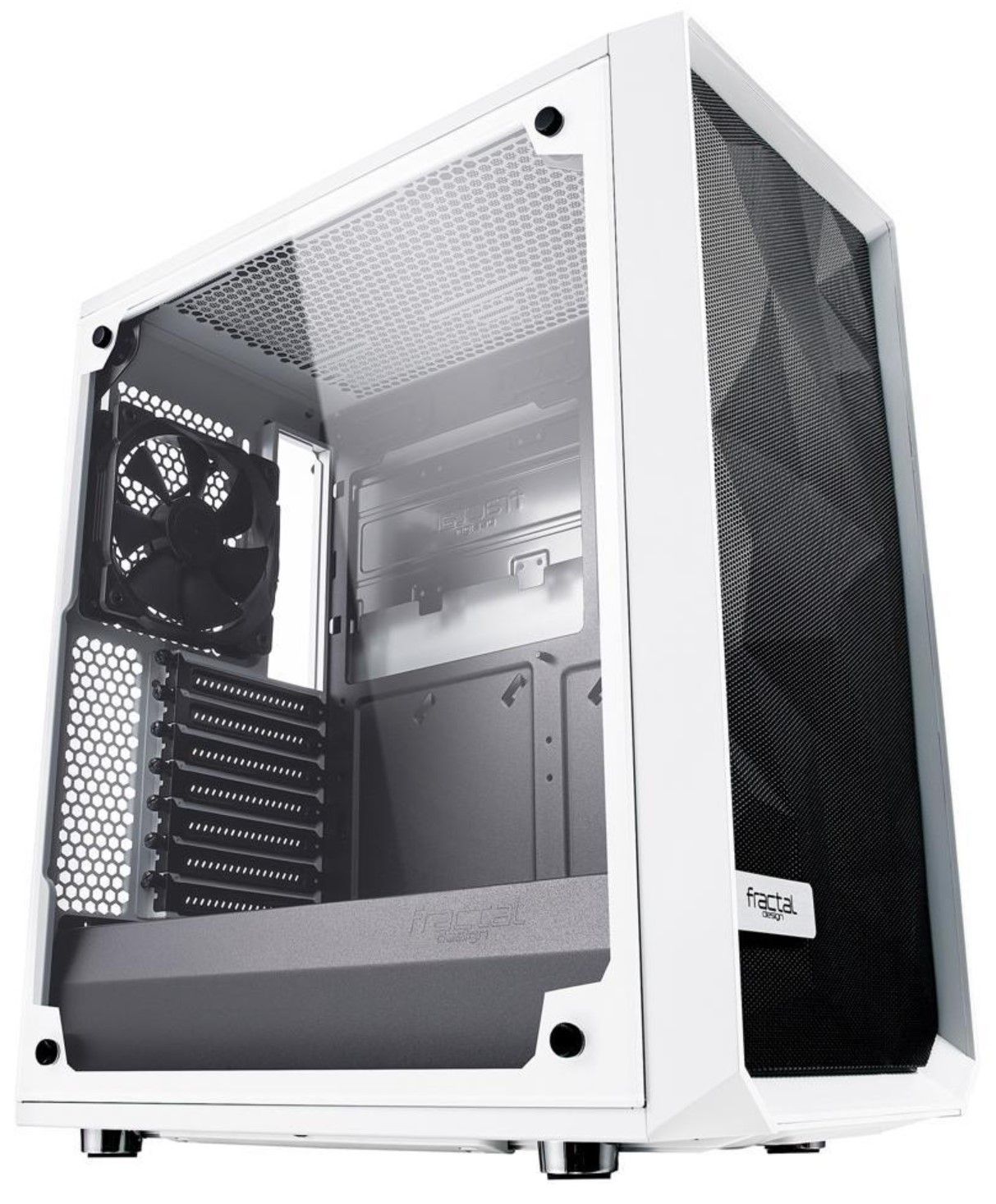
Fractal Design Meshify C
Best White Budget PC Case
The Fractal Design Meshify C is a case that stands out from the crowd of mid-tower options. The mesh front of the case offers a distinctive angular appearance, and the material also promotes airflow in and out of the chassis. The Meshify C manages to accommodate gamers who need the space of a full tower in a smaller form factor. With space for 7 fan mounts, a liquid cooling radiator, and 5 hard drives, the Meshify C is ready to grow with gamers as their evolving rigs demand.
- Brand
- Fractal Design
- Motherboard Size (Max.)
- ATX, mATX, ITX
- Graphics Card Size (Max.)
- 12.4 inches
- 3.5″ Drive Slots
- 2
- Viewing Window
- Yes
- 2.5″ Drive Slots
- 3
- Power Supply Size (Max.)
- 175 mm
- Exterior Dimensions
- 17.83″ x 8.35″ x 16.10″
- Distinctive mesh front panel
- Can hold seven fan mounts and five hard drives
- Multitude of dust filters
- Simplistic I/O panel
- Doesn’t support largest motherboards
Previously, Fractal Design was not known as a manufacturer of budget PC cases, creating some truly trend-setting enclosures. Recently, the company has brought more affordable and compact options to the market, including the mid-tower Meshify C. This white version of this case is ideal for gamers who want more than just a black case done in a white color scheme. The lighter trim of the Meshify C is a striking contrast to the darker angular design of the front mesh panel.
Of course, as its name implies, the Meshify C focuses on its perforated front, which invites air to travel in and out of the case easily. Uninterrupted air flow is what Fractal Design is aiming for with this case, and accordingly, has removed any hard drive trays from the front of the chassis. Instead, the company encourages some strategic storage placement either on the sides of the case’s interior or on the bottom adjacent to the power supply.
The case can hold up to three SSDs and two full-sized hard drives using these installation points. The added space in the case also has other benefits, clearing the way for high-end graphics cards and making installing up to seven cooling fans realistic. Some cases ignore the inevitability of dust, which usually finds its way inside cases and on the surface of components. The Meshify C empowers gamers to deal with this annoyance as efficiently as possible, with easy-to-access dust filters on the top, bottom, and front of the case.
The Meshify C is definitely on the smaller side for a mid-tower case, and there are a few compromises buyers will have to make. Sadly, the case will not hold the largest E-ATX motherboards, at least without blocking some vital areas or complicating cable management. Also, if a gamer installs a 360 mm radiator for liquid cooling near the front panel, it may limit options for using a full-sized power supply. Even so, for budget PC builders, it’s unlikely they will select expensive motherboards or elaborate water-cooling systems for an affordable rig.
Many case manufacturers leave users on their own to figure out the best routes for cable management. Fractal Design takes a different approach, almost begging gamers to maximize the generous 35 mm of free space behind the motherboard tray with pass-through sections complete with grommets.
The Fractal Design Meshify C is worthy of consideration for the most premium gaming PC builds and looks especially dashing in white. As one of the best budget PC cases, the Meshify C belongs at the top of any gamer’s list when searching for a stylish compact case that offers the flexibility of a larger chassis.
So Many Cases and So Little Money?
Even though they have become more elaborate over the years with RGB fans and glass panels, PC cases are reasonably affordable parts of any build. When on a limited budget, there are ample choices that make deciding on the suitable case for a build problematic. To find the best case for a new system, these qualities can quickly sort through the possibilities:
Form Factor
A case’s form factor is a vital part of the decision-making process, as it will determine which components like motherboards and graphics cards can join other parts in a potential build. The Phanteks Enthoo Pro 2 is an example of a budget full-sized case that can hold as many as 12 hard drives or 11 SSDs. However, whether a gamer settles on a more compact case like the Thermaltake Versa H18 or a full-tower candidate, many of these cases accommodate anything from mini ITX to full-sized ATX motherboards. There is also no shortage of shapes that enclosures can come in, with the Thermaltake The Tower 100 saving more space by adding height to its dimensions rather than its width or depth.
Cooling and Airflow
As powerful graphics cards have become the centerpiece and most expensive component of most gaming rigs, they often pose problems as far as fitting in cases and blocking airflow. Fortunately, enclosures like the Cooler Master MasterBox Q300L have found ingenious ways to contain these increasingly mammoth graphics cards even in the most miniature chassis. Cooling is still a concern, especially with less open space for fans to circulate air. The best budget PC cases keep the path from the front of the case to the back as clear as possible, while including mounting points for liquid cooling systems. Cable management also plays a role in keeping temperatures down, but cases typically have areas designated to route air-blocking cords.
Mesh panels are the most popular way to keep air moving in and out of cases, with the Phanteks Eclipse G360A a testament to this material’s effectiveness. This mid-tower case relies on a barely noticeable ultra-fine mesh that consumes nearly the entire front panel of the enclosure.
Build Quality
Buying an inexpensive case doesn’t necessarily mean it will only last months. The Antec Performance Series P7 Neo ditches features like tempered glass windows and ARGB fans, focusing on steel parts that make it one of the most durable budget cases.
Aesthetics
Finally, for gamers, style is a more important factor than ever when shopping for a case that best reflects a personality or matches the theme of a gaming room. Dull-looking cases are a thing of the past, and many choices feature similar elements, like tempered glass panels seen with the Fractal Design Meshify C White. Today, it’s common for cases to be sold in many different colors and configurations. The MSI MAG Forge 112R takes things further with four included ARGB fans and a controller that allows changing lighting effects with a button.
As this guide has shown, a finite budget does not prevent a gamer from finding a case that is the right size for a setup, cools key components adequately, and complements other cutting-edge peripherals. The Lian Li Lancool 216 is GameRant’s top pick for a budget PC case because of its unbeatable combination of affordability, cooling performance, and expandability.
FAQ
Q: What size PC case should I buy?
Whether you should purchase a mini-ITX, mid-tower, or full-tower case depends on which motherboard/CPU combo you select for a PC build. However, most medium-sized and large cases accommodate a wide range of motherboard sizes, so the choice also depends on available desk space, storage requirements, and budget.
Q: How do I know if my components will fit in a PC case?
Even smaller PC cases are designed to accommodate the most common components in a condensed area. Still, it’s best to check the specs of a case to ensure that long graphics cards will fit and that storage bays will hold a suitable number of hard drives.
Q: How can I save money when buying a PC case?
Look for cases that include at least 2-3 pre-installed cooling fans or RGB controllers to avoid extra expenses. Although it has become more uncommon, some cases may still be bundled with power supplies.
